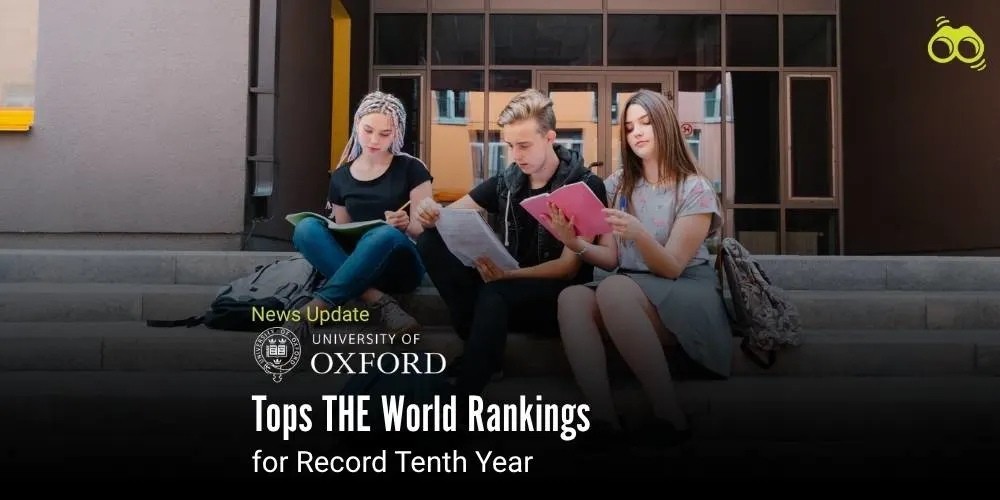University of Oxford Maintains First Place in Global Higher Education Ranking
Oxford Leads 2026 World University Rankings Amid Global Competition
The most recent version of the World University Rankings, issued by Times Higher Education, has again listed the University of Oxford at number one on the global list. As 2,191 universities from 115 nations were ranked, this was Oxford's tenth consecutive year as number one in the world, a feat no other in the 21-year history of the rankings. Oxford’s sustained success is noteworthy as only Harvard and Caltech have previously surpassed it in rankings. As the Vice-Chancellor, Professor Irene Tracey, stated that this achievement is a testament to the dedication of Oxford’s academic and professional staff and students. While acknowledging the global respect for rankings as a measurement of higher education performance, she also drew attention to the surging pressures faced by the UK education sector. She also urged that there is a need for fresh investment to make sure universities can continue to lead discovery, opportunity and economic growth.
Phil Baty, Times Higher Education's Chief Global Affairs Officer, called Oxford's success remarkable, particularly in the face of stiff competition from Top US Universities and rapidly emerging Asian Universities, specifically those in China. He cited that Oxford's excellence is not just found in its performance on all 18 ranking indicators but in the strong international focus and a drive to bring in global talent and create cross-border cooperation as well.
The World Education University Rankings have been processed after their analysis of about 19 million research articles, the 1.5 million outcomes of scholarly reputation surveys, and records of more than 3,000 educational institutions worldwide. This whole approach encompasses: teaching, research environment, quality of research, international attractiveness and industry engagement as the five core areas. The latter two are the areas where Oxford scores particularly high, while it is also present high level in all overall categories on research productivity and international collaboration.
The announcement was made during the World Academic Summit on 8th October and attended by close to 800 visitors from countries outside the USA. It included MIT in second place in the Global University Ranking, followed by Cambridge in third place, tied with Princeton. The facts and figures paint a clear picture of the Top Universities in the World, as well as answering some of the following questions: What will be the effect of global educational changes on the 2026 World University Rankings? Top 10 world universities in 2026. What is the current standing of Asian universities with respect to US universities in terms of the present rankings? What are the factors that influence Times Higher Education World University Rankings? Which countries have the top universities in 2026?
To sum it up, the longer duration of reign for Oxford in the Best Universities in the World league tables indicates much about sustained excellence, coupled with global connectivity as well as directed investments in higher learning. This also further cements the UK's status as one of the leading international destinations for students pursuing world-class educational opportunities.
Editor’s Note:
Oxford University's ten-year dominance at the top of the Times Higher Education World University Rankings is not merely a victory for tradition—it is a demonstration of consistent excellence in a highly competitive international environment. In an era when Asian universities are emerging quickly and Top US Universities are increasingly enjoying massive government funding, Oxford's continued hold on the number-one position says much about its scholarly richness, research intensity, and global thinking. What is noteworthy is Oxford's steady performance on all 18 ranking criteria, especially on research environment and international outlook. It is this equilibrium, between profound scholarship and cosmopolitan engagement, that a genuinely world-leading university possesses. Amidst a changing higher education landscape, where questions such as Which nations have the best universities in 2026 or How do Asian universities rank against US universities in current rankings are more pertinent than ever before, Oxford's standing provides an obvious benchmark.
Skoobuzz believes that Oxford University’s enduring leadership in the Times Higher Education World University Rankings reflects more than institutional prestige; it signals a model of academic resilience and global relevance. As higher education continues to evolve amid shifting geopolitical, technological, and funding landscapes, Oxford’s example offers a clear standard for what sustained excellence looks like. Its balance of rigorous scholarship and international engagement serves as a reminder that the world’s best universities are those that remain committed to advancing knowledge, fostering collaboration, and shaping the future across borders.
FAQs
1. What is Oxford University's current position in the Times Higher Education World University Rankings?
Oxford University is ranked number one globally in the 2026 edition of the Times Higher Education World University Rankings. This marks its tenth consecutive year at the top.
2. How many universities were assessed in the 2026 World University Rankings?
A total of 2,191 universities from 115 countries were evaluated in the latest rankings.
3. What makes Oxford University consistently top-ranked?
Oxford performs strongly across all 18 ranking indicators, with particular strengths in research environment and international outlook. Its commitment to global collaboration and academic excellence contributes to its sustained leadership.
4. What are the five core areas used to calculate the Times Higher Education rankings?
The rankings are based on teaching, research environment, research quality, international outlook, and industry engagement.
5. How does Oxford compare to other top universities in the 2026 rankings?
Oxford is ranked first, followed by MIT in second place. Cambridge and Princeton share third position. Oxford’s lead is notable given strong competition from top US and Asian universities.
6. Why is Oxford’s international outlook considered a key strength?
Oxford excels in attracting global talent, fostering international research partnerships, and maintaining a diverse academic community—factors that significantly boost its ranking.
7. What challenges does the UK higher education sector currently face?
According to Oxford’s Vice-Chancellor, the sector is under financial strain and requires renewed investment to remain globally competitive and continue driving innovation and opportunity.
8. How do Asian universities compare to US institutions in the 2026 rankings?
Asian universities, particularly in China, continue to rise but face stiff competition from well-funded US institutions. Oxford’s performance remains ahead of both groups.
9. What is the significance of Oxford’s ten-year reign at the top?
Oxford’s decade-long dominance is unprecedented in the 21-year history of the rankings. It reflects not only academic prestige but also resilience, strategic investment, and global relevance.
10. What does Oxford’s ranking mean for international students?
Oxford’s top position reinforces the UK’s status as a leading destination for world-class education, offering students access to high-quality teaching, research, and global networks.














0 Comments (Please Login To Continue)